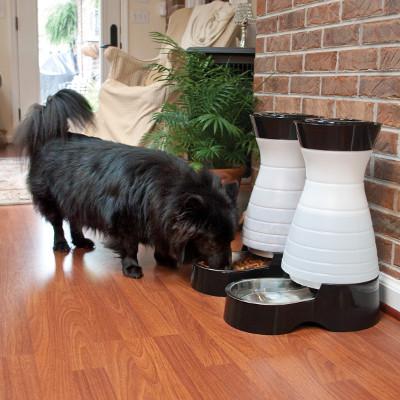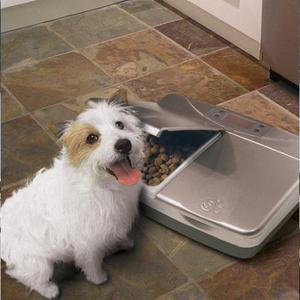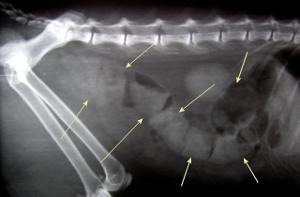Choosing a proper diet for your pet can be much more complicated than it used to be. When commercial dog food was first introduced in the early 1900s, the choices were very limited. Today there are so many options! You may wonder what the differences really are.
 Puppy Food
Puppy Food
Puppies usually discover solid food at around 3-4 weeks of age. They romp through their mother's food bowl, get their paws covered in food, and then lick them clean. By 5 or 6 weeks of age, they have often completely weaned themselves onto solid food.
Most puppies experience the bulk of their growth during the first 6 months of life. This is the time when their nutritional needs are the greatest. Puppies require 2x the energy in calories as an adult of the same weight. Puppies also require about 20% more protein and essential amino acids than adult dogs. Calcium and phosphorus must be fed in the correct ratio to support growing bones.
The goal of feeding a puppy is to help him grow into a healthy adult. This is why it's so important to feed your pup a complete and balanced food made for growing puppies. Look for a food that was tested using feeding trials. This means that the diet was actually fed to puppies and not just formulated by laboratory analysis.
Your large or giant breed puppy has special needs. These pups can develop orthopedic problems if they are overfed and grow too quickly. Look for a diet formulated especially for them.
 Adult Food
Adult Food
You should transition your puppy to an adult maintenance food when he reaches maturity. For small breeds, this will be at about 1 year of age. Large and giant breeds may not be considered fully grown until they are 2 years old.
When choosing a diet for your adult dog, be sure it's labeled "complete and balanced". In order for a pet food to make this claim, it must meet the nutritional standards established by AAFCO. The Association of American Feed Control Officers sets the standard for pet foods in the United States. In order to make this claim, it must be validated by laboratory analysis or laboratory analysis plus actual feeding trials.
Some pet foods are formulated by laboratory analysis only. This means the food has met the minimum nutritional requirements set by AAFCO. It ensures that all nutrients essential to your dog's health like protein, fat, certain vitamins and minerals, and fiber are adequate. This food is based on a similar product that has been through feeding trials. It is called a member of a "product family".
A pet food that have been tested by "feeding trials" have also been formulated by laboratory analysis. But then it is fed to real dogs using AAFCO protocols. The use of feeding trials is superior to other methods to determine nutritional adequacy. These trials last from weeks to months. The benefit of a feeding trial is that you can see by their shiny hair coat, bright eyes and good energy level that the food provides them the nutrition they need to stay healthy and happy. Feeding trials also prove that dogs like the food. And doesn't everyone want to know that their dog enjoys his food? This is something that a laboratory analysis can't tell you.
 Senior Food
Senior Food
You may think that as your dog enters his senior years he should begin eating a "Senior" diet. In fact, there are no official dietary requirements set for older dogs. All senior diets are different and may not be appropriate for your dog. Your pet may not need to change his diet at all unless he is having health issues.
Many dogs do become less active as they age. This means they should eat fewer calories to avoid gaining weight. Many people think that a senior diet will have fewer calories than one formulated for adult maintenance. This is not necessarily true. A sampling of "senior diets" showed a range from 246 to 408 calories per 8 ounce cup. That's a difference of over 150 calories!
Many people also think that foods designed for seniors would contain less protein, fat, and sodium. Again, the results varied greatly depending on the manufacturer.
All Life Stages Dog Food
Some pet foods are labeled "all life stages". This means that the diet has met the stringent requirements for growth and reproduction. Since this food can meet the needs of growing puppies, it may not necessarily be appropriate for your adult or senior dog.
If you have any questions or concerns, you should always talk to your vet. This is the best way to ensure that you are feeding your pet appropriately for all stages of his life.





